Abstract
Guinea-pigs made tolerant to dinitrochlorobenzene (by prior intracardiac injection of dinitrobenzene sulphonate) failed to give positive skin reactions after contact sensitization, but nevertheless had peritoneal cells which reacted with the hapten in macrophage migration inhibition (MMI) tests. This reactivity was blocked in vitro by the addition of serum from tolerant animals but not by serum from hypersensitive animals.
Cells from hypersensitive guinea-pigs were anomalous, in that their reaction with hapten in MMI was not blocked by tolerant serum. Hypersensitive serum, though not active by itself in MMI, was able to prevent blocking by tolerant serum when the two sera were mixed. This was interpreted as an `unblocking' phenomenon and suggested that hypersensitive cells were insusceptible to blocking because they themselves produced an unblocking substance (antibody?), although preliminary efforts to demonstrate this directly were not successful. Hypersensitive serum had an analogous activity in vivo, since when passively transferred to otherwise tolerant animals it enabled them to produce typical skin reactions; that is, it broke tolerance.
Tolerance or non-reactivity in vivo in the situation investigated thus appears to be an enhancement-like process, characterized by the presence of reactive lymphoid cells and a blocking factor (antigen–antibody complex?) detectable in the serum of the tolerant animals.
Full text
PDF


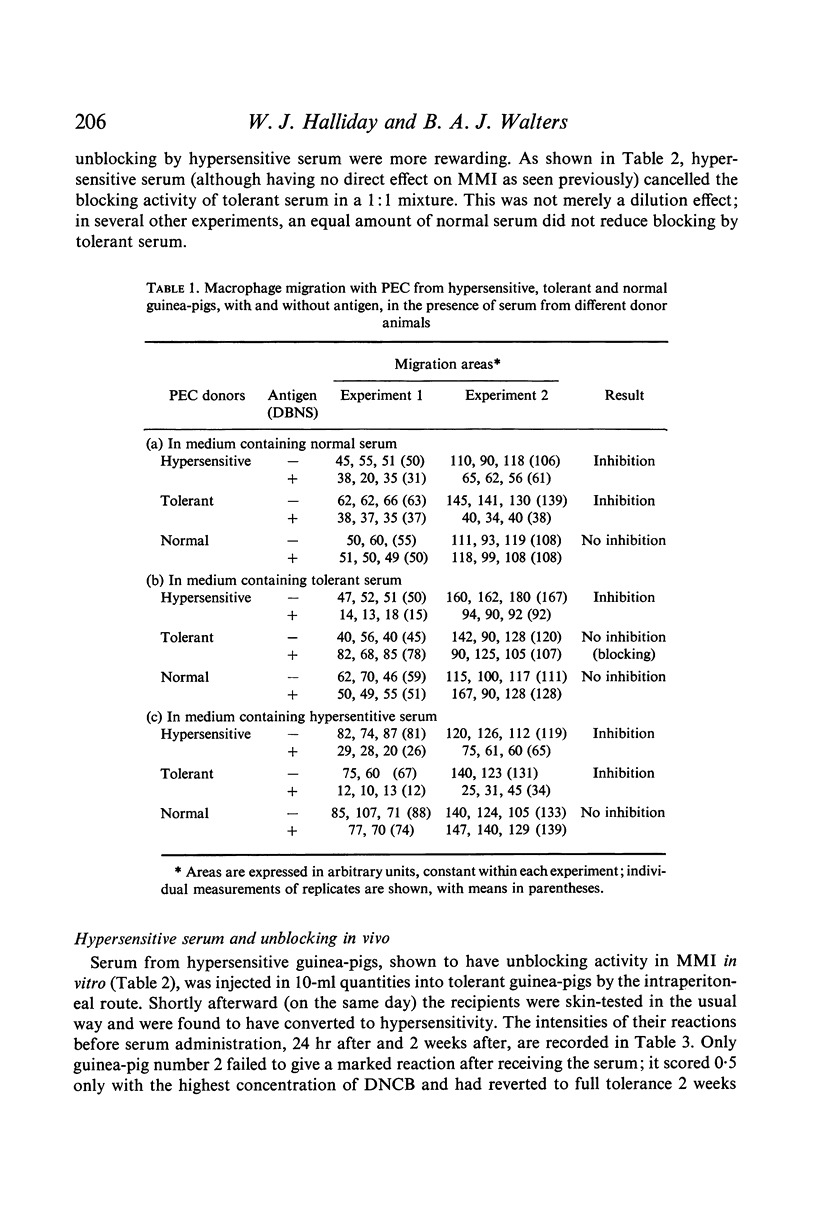
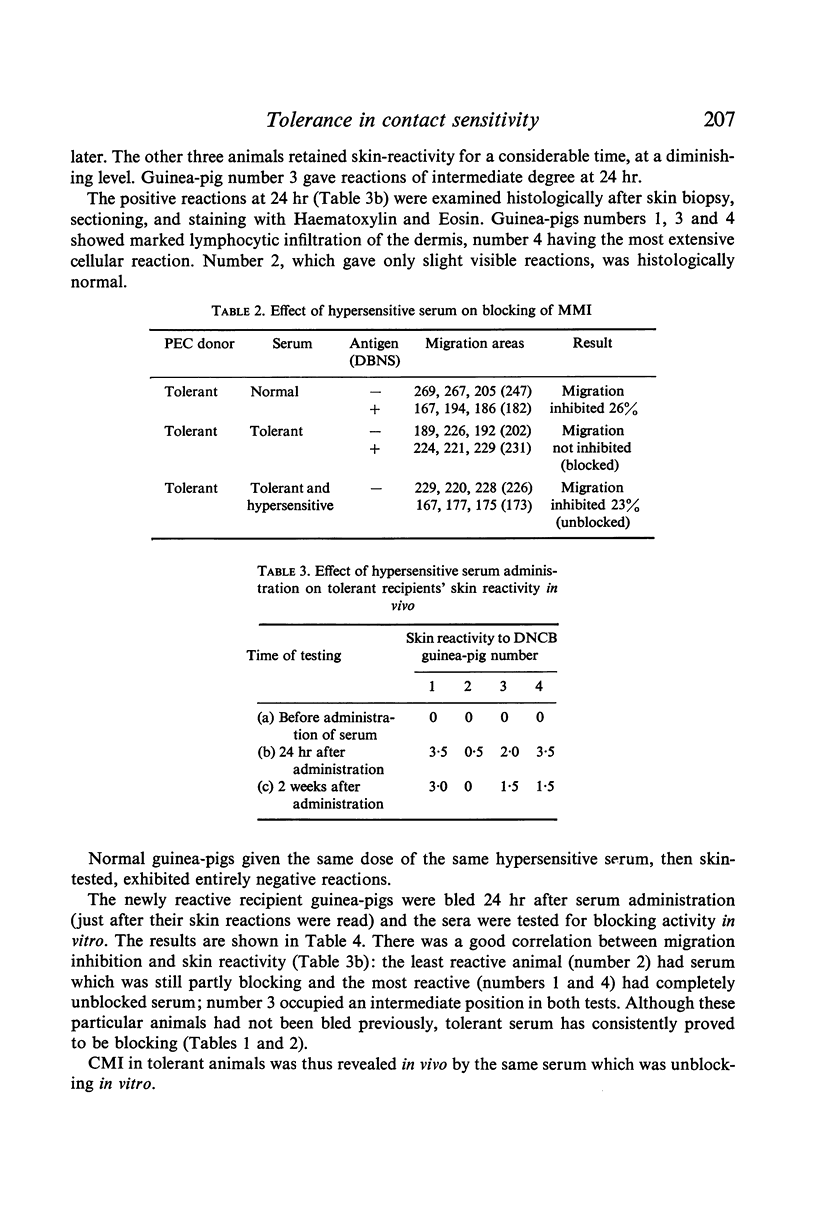
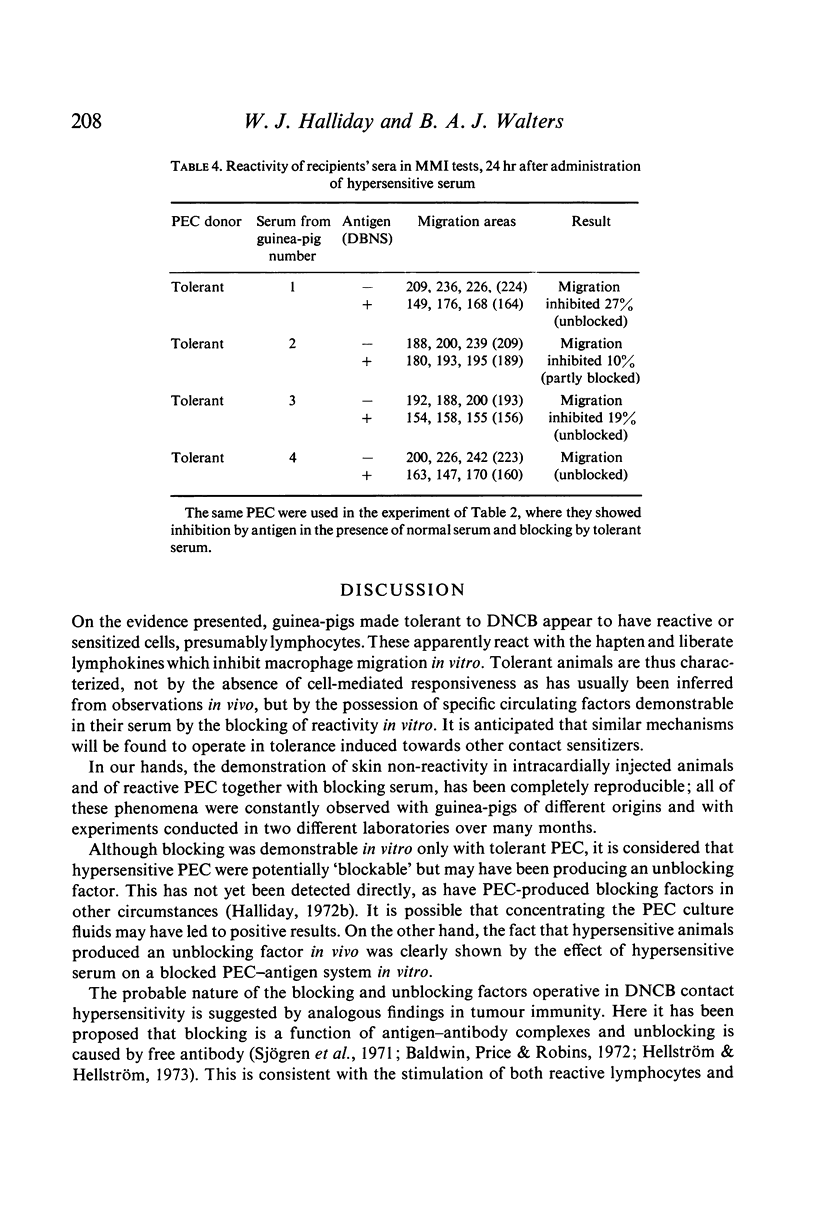
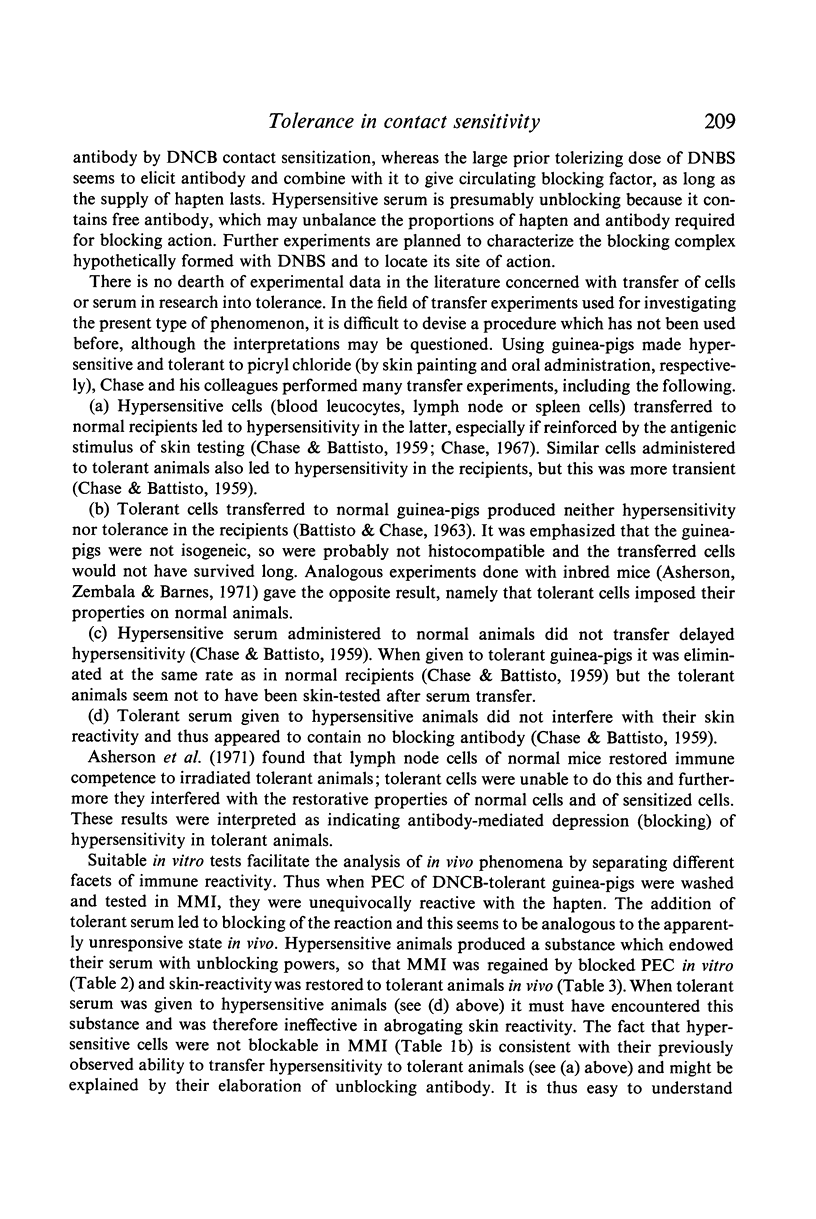

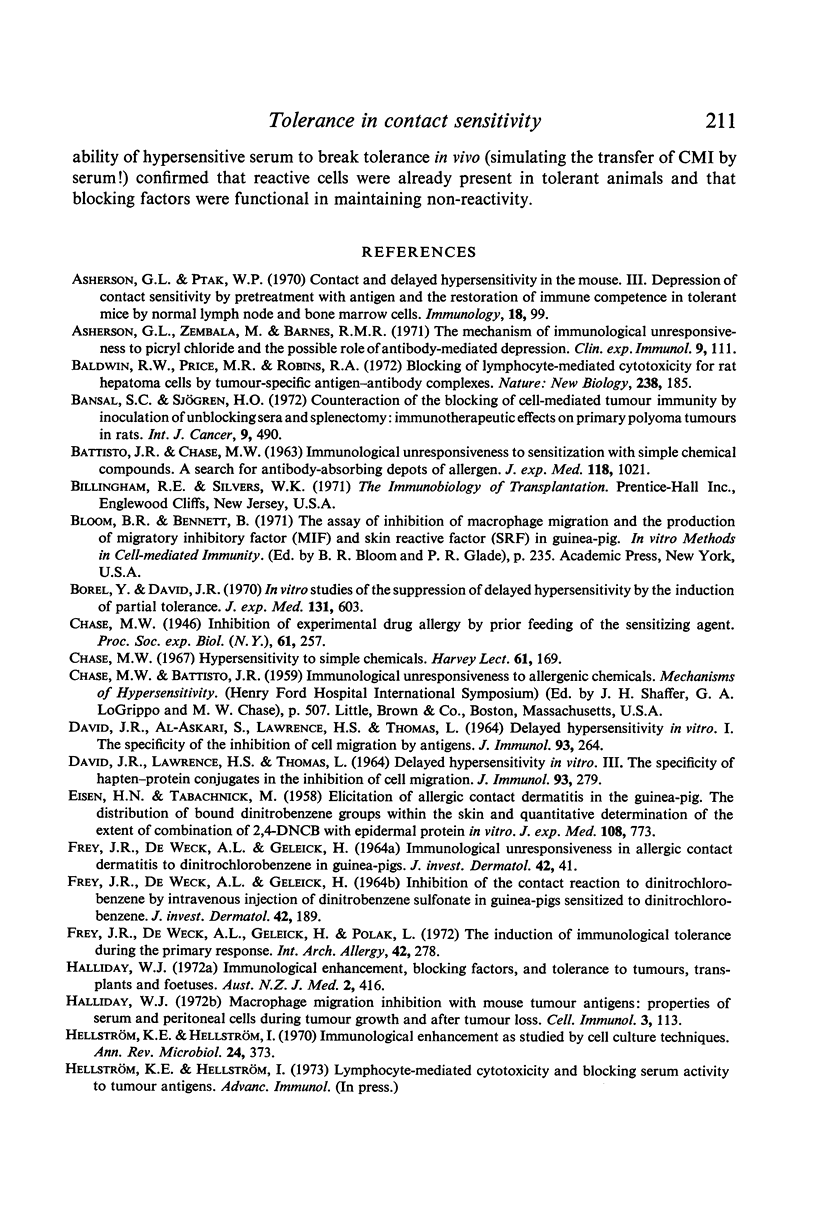
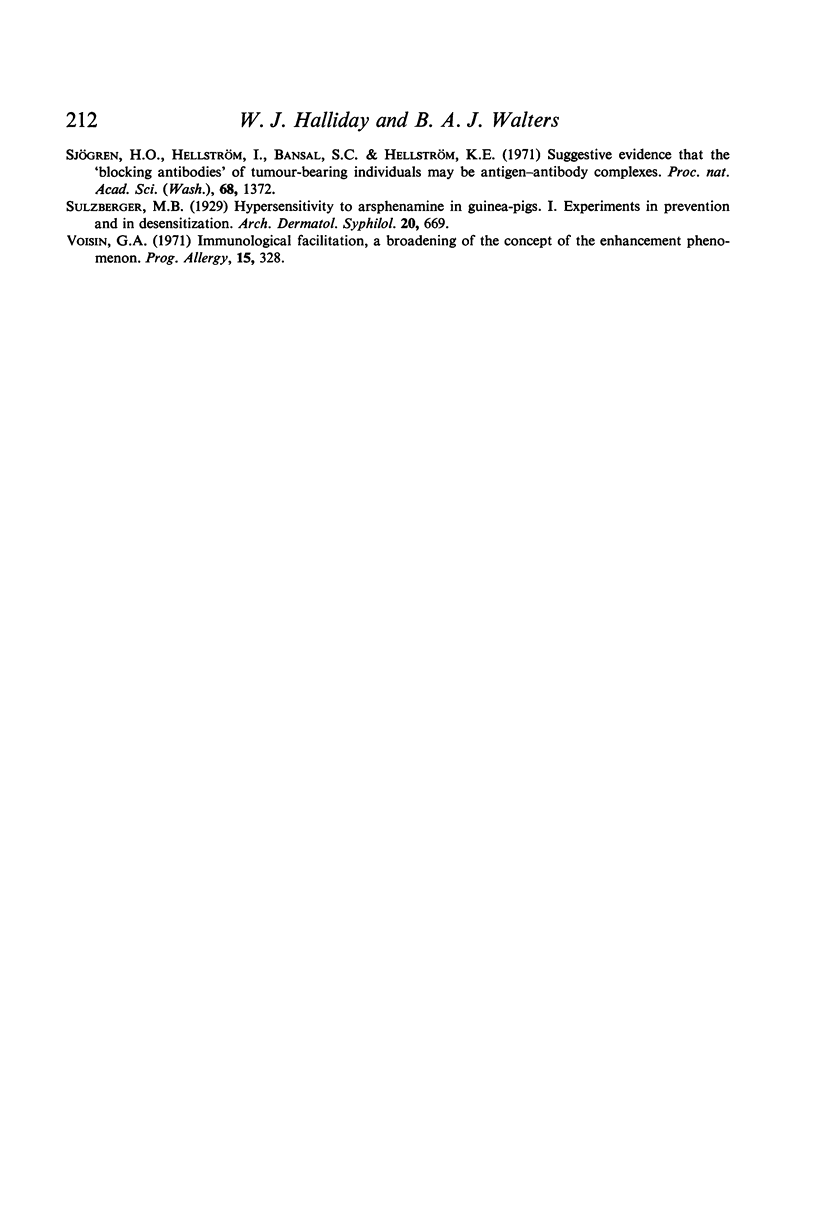
Selected References
These references are in PubMed. This may not be the complete list of references from this article.
- Asherson G. L., Ptak W. Contact and delayed hypersensitivity in the mouse. 3. Depression of contact sensitivity by pre-treatment with antigen and the restoration of immune competence in tolerant mice by normal lymphoid and bone marrow cells. Immunology. 1970 Jan;18(1):99–106. [PMC free article] [PubMed] [Google Scholar]
- Asherson G. L., Zembala M., Barnes R. M. The mechanism of immunological unresponsiveness to picryl chloride and the possible role of antibody mediated depression. Clin Exp Immunol. 1971 Jul;9(1):111–121. [PMC free article] [PubMed] [Google Scholar]
- BATTISTO J. R., CHASE M. W. IMMUNOLOGICAL UNRESPONSIVENESS TO SENSITIZATION WITH SIMPLE CHEMICAL COMPOUNDS; A SEARCH FOR ANTIBODY-ABSORBING DEPOTS OF ALLERGEN. J Exp Med. 1963 Dec 1;118:1021–1035. doi: 10.1084/jem.118.6.1021. [DOI] [PMC free article] [PubMed] [Google Scholar]
- Baldwin R. W., Price M. R., Robins R. A. Blocking of lymphocyte-mediated cytotoxicity for rat hepatoma cells by tumour-specific antigen-antibody complexes. Nat New Biol. 1972 Aug 9;238(84):185–186. doi: 10.1038/newbio238185a0. [DOI] [PubMed] [Google Scholar]
- Bansal S. C., Sjögren H. O. Counteractions of the blocking of cell-mediated tumor immunity by inoculation of unblocking sera and splenectomy: immunotherapeutic effects on primary polyoma tumors in rats. Int J Cancer. 1972 May 15;9(3):490–509. doi: 10.1002/ijc.2910090306. [DOI] [PubMed] [Google Scholar]
- Borel Y., David J. R. In vitro studies of the suppression of delayed hypersensitivity by the induction of partial tolerance. J Exp Med. 1970 Mar 1;131(3):603–610. doi: 10.1084/jem.131.3.603. [DOI] [PMC free article] [PubMed] [Google Scholar]
- Chase M. W. Hypersensitivity to simple chemicals. Harvey Lect. 1967;61:169–203. [PubMed] [Google Scholar]
- DAVID J. R., AL-ASKARI S., LAWRENCE H. S., THOMAS L. DELAYED HYPERSENSITIVITY IN VITRO. I. THE SPECIFICITY OF INHIBITION OF CELL MIGRATION BY ANTIGENS. J Immunol. 1964 Aug;93:264–273. [PubMed] [Google Scholar]
- DAVID J. R., LAWRENCE H. S., THOMAS L. DELAYED HYPERSENSITIVITY IN VITRO. 3. THE SPECIFICITY OF HAPTEN-PROTEIN CONJUGATES IN THE INHIBITION OF CELL MIGRATION. J Immunol. 1964 Aug;93:279–282. [PubMed] [Google Scholar]
- EISEN H. N., TABACHNICK M. Elicitation of allergic contact dermatitis in the guinea pig; the distribution of bound dinitrobenzene groups within the skin and quantitative determination of the extent of combination of 2,4-dinitro-chlorobenzene with epidermal protein in vivo. J Exp Med. 1958 Dec 1;108(6):773–796. doi: 10.1084/jem.108.6.773. [DOI] [PMC free article] [PubMed] [Google Scholar]
- FREY J. R., DE WECK A. L., GELEICK H. IMMUNOLOGICAL UNRESPONSIVENESS IN ALLERGIC CONTACT DEMATITIS TO DINITROCHLOROBENZENE IN GUINEA PIGS. J Invest Dermatol. 1964 Jan;42:41–47. doi: 10.1038/jid.1964.11. [DOI] [PubMed] [Google Scholar]
- FREY J. R., DEWECK A. L., GELEICK H. INHIBITION OF THE CONTACT REACTION TO DINITROCHLOROBENZENE BY INTRAVENOUS INJECTION OF DINITROBENZENE SULFONATE IN GUINEA PIGS SENSITIZED TO DINITROCHLOROBENZENE. J Invest Dermatol. 1964 Feb;42:189–196. doi: 10.1038/jid.1964.41. [DOI] [PubMed] [Google Scholar]
- Frey J. R., De Weck A. L., Geleick H., Polak L. The induction of immunological tolerance during the primary response. Int Arch Allergy Appl Immunol. 1972;42(2):278–299. doi: 10.1159/000230612. [DOI] [PubMed] [Google Scholar]
- Halliday W. J. Immunological enhancement, blocking factors, and tolerance to tumours, transplants and foetuses. Aust N Z J Med. 1972 Nov;2(4):416–421. doi: 10.1111/j.1445-5994.1972.tb03948.x. [DOI] [PubMed] [Google Scholar]
- Halliday W. J. Macrophage migration inhibition with mouse tumor antigens: properties of serum and peritoneal cells during tumor growth and after tumor loss. Cell Immunol. 1972 Jan;3(1):113–122. doi: 10.1016/0008-8749(72)90231-6. [DOI] [PubMed] [Google Scholar]
- Hellström K. E., Hellström I. Immunological enhancement as studied by cell culture techniques. Annu Rev Microbiol. 1970;24:373–398. doi: 10.1146/annurev.mi.24.100170.002105. [DOI] [PubMed] [Google Scholar]
- Sjögren H. O., Hellström I., Bansal S. C., Hellström K. E. Suggestive evidence that the "blocking antibodies" of tumor-bearing individuals may be antigen--antibody complexes. Proc Natl Acad Sci U S A. 1971 Jun;68(6):1372–1375. doi: 10.1073/pnas.68.6.1372. [DOI] [PMC free article] [PubMed] [Google Scholar]
- Voisin G. A. Immunological facilitation, a broadening of the concept of the enhancement phenomenon. Prog Allergy. 1971;15:328–485. [PubMed] [Google Scholar]


